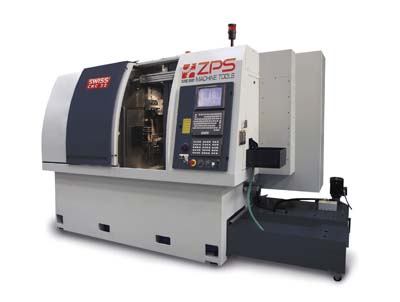
ZPS America LLC announces its newest Swiss CNC, the ZPS Swiss. ZPS has designed the Swiss CNC by combining traditional mechanical knowledge with the most up-to-date developments. The ZPS Swiss series covers the range from 3 to 32mm bar diameter. The rigid, European-built machine is designed for continuous or series production of precision turned parts. Solid base casting ensures maximum rigidity and stability.
The Swiss style turning centers provide outstanding accuracy and quality surface finish conditions for precision parts. The machines are equipped with the GE Fanuc 160i control systems and drives that are capable of handling up to 12 controlled axes.
The specially developed programming software, Swiss Plus, simplifies the programming so the programmer takes in consideration only the X- and Z-axes during programming just as on typical two-axis CNC lathes. Swiss Plus operates with Windows and offers user-friendly programming specially adapted for simultaneous operations. Each machining operation is individually programmed in ISO code with graphic interface and tool library. Swiss Plus generates the part program by taking into consideration the machine kinematics and machine requirements. The Swiss Plus, integrated in the Fanuc 18i controls, or programmed off line, ensures the full benefit from ZPS Swiss' performance.
It's possible to machine a part with up to 4 tools cutting simultaneously. The sliding headstock provides up to 250mm stroke that enables part machining in succession at one collet clamping as well as the machining of long parts with small diameter. There are 23 tool stations and 14 stations can be driven, so the machine can finish the most complex parts that are otherwise machined in several operations. The use of two identical spindles increases machining capacity in rear slide operations and enables evacuation of long parts (more than 250mm) through the subspindle. The extraordinarily rigid structure of the cast steel machine base provides optimum machining conditions.
Right from machine set up to production, ZPS Swiss' ergonomics and accessibility increase productivity. Three live spindles may be fitted on the rear tool rack for cross drilling and tapping as well as milling with the Y-axis. Multiple live spindles also enable high-speed drilling, polygon turning or thread and slot-milling. Two axial and three transversal live spindles may be fitted on the rear machining unit in order to work via the subspindle. Out of the 24 tools available at least 16 can be driven. To accomplish nearly any operation the machines can be provided with a wide range of optional equipment, including NC drive of the pick-up spindle, bar stock feeding and clamping, attachments for high-speed drilling, reaming, tapping and broaching, and multi-spindle drilling heads on the frontal slides.
Contact Details
Related Glossary Terms
- broaching
broaching
Operation in which a cutter progressively enlarges a slot or hole or shapes a workpiece exterior. Low teeth start the cut, intermediate teeth remove the majority of the material and high teeth finish the task. Broaching can be a one-step operation, as opposed to milling and slotting, which require repeated passes. Typically, however, broaching also involves multiple passes.
- centers
centers
Cone-shaped pins that support a workpiece by one or two ends during machining. The centers fit into holes drilled in the workpiece ends. Centers that turn with the workpiece are called “live” centers; those that do not are called “dead” centers.
- collet
collet
Flexible-sided device that secures a tool or workpiece. Similar in function to a chuck, but can accommodate only a narrow size range. Typically provides greater gripping force and precision than a chuck. See chuck.
- computer numerical control ( CNC)
computer numerical control ( CNC)
Microprocessor-based controller dedicated to a machine tool that permits the creation or modification of parts. Programmed numerical control activates the machine’s servos and spindle drives and controls the various machining operations. See DNC, direct numerical control; NC, numerical control.
- gang cutting ( milling)
gang cutting ( milling)
Machining with several cutters mounted on a single arbor, generally for simultaneous cutting.
- milling
milling
Machining operation in which metal or other material is removed by applying power to a rotating cutter. In vertical milling, the cutting tool is mounted vertically on the spindle. In horizontal milling, the cutting tool is mounted horizontally, either directly on the spindle or on an arbor. Horizontal milling is further broken down into conventional milling, where the cutter rotates opposite the direction of feed, or “up” into the workpiece; and climb milling, where the cutter rotates in the direction of feed, or “down” into the workpiece. Milling operations include plane or surface milling, endmilling, facemilling, angle milling, form milling and profiling.
- numerical control ( NC)
numerical control ( NC)
Any controlled equipment that allows an operator to program its movement by entering a series of coded numbers and symbols. See CNC, computer numerical control; DNC, direct numerical control.
- tapping
tapping
Machining operation in which a tap, with teeth on its periphery, cuts internal threads in a predrilled hole having a smaller diameter than the tap diameter. Threads are formed by a combined rotary and axial-relative motion between tap and workpiece. See tap.
- turning
turning
Workpiece is held in a chuck, mounted on a face plate or secured between centers and rotated while a cutting tool, normally a single-point tool, is fed into it along its periphery or across its end or face. Takes the form of straight turning (cutting along the periphery of the workpiece); taper turning (creating a taper); step turning (turning different-size diameters on the same work); chamfering (beveling an edge or shoulder); facing (cutting on an end); turning threads (usually external but can be internal); roughing (high-volume metal removal); and finishing (final light cuts). Performed on lathes, turning centers, chucking machines, automatic screw machines and similar machines.






